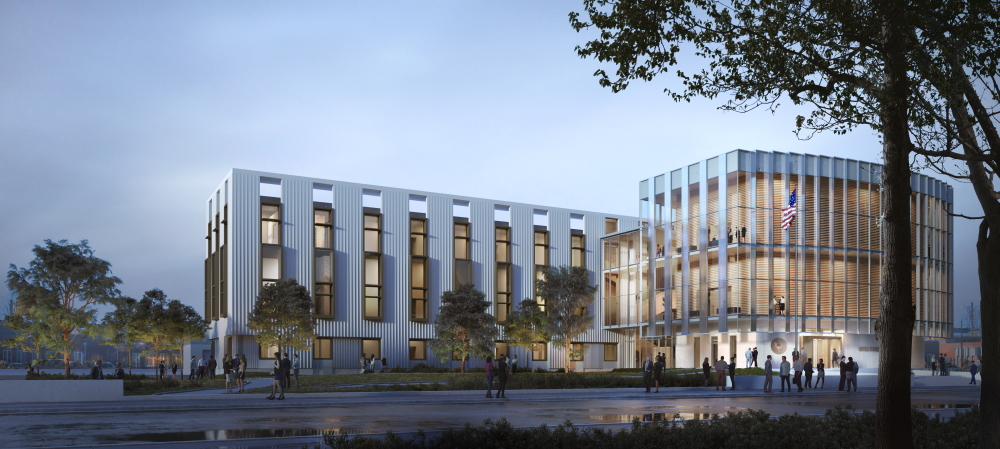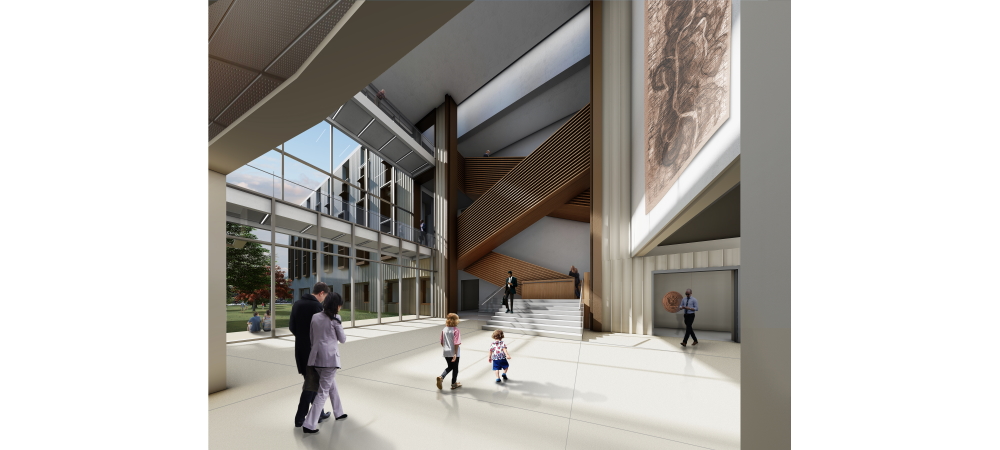
Photos credit to Duvall Decker Architects
The United States District Court of the Northern District of Mississippi is pleased to share the concept design for the new courthouse in Greenville, MS. The new Greenville courthouse is designed to be a highly functional working courthouse for the administration of justice. It is also designed to be a handsome addition to the landscape and character of downtown Greenville.
“On behalf of the entire United States District Court for the Northern District of Mississippi, let me just say that we are absolutely thrilled with the design of our new Courthouse so far, and we are so excited about what this building will mean for Greenville and the surrounding areas. So much hard work has gone into this project, and there is a lot more to be done, but this building promises to be a beautiful new landmark building and a real asset to the community.” The Honorable Sharion Aycock, Chief Judge

Photos credit to Duvall Decker Architects
“The new courthouse will both mark and define the next era in Greenville’s history and the evolution of Mississippi’s federal court presence. Its unique and functional design will generate national attention in multiple fields.” The Honorable Debra Brown, District Judge

Photos credit to Duvall Decker Architects
The architect’s design concept statement from Duvall Decker Architects and Eskew+Dumez+Ripple Architects:
New US Courthouse in Greenville, Mississippi
A GSA Design Excellence Project
The Design
All building designs are expected to meet many requirements: they should be functional, efficient, sustainable, durable, healthy, and built within a budget. Certain public structures, those that aspire to serve our society and represent our culture, must do more. They must strive to be meaningful, to promote inquiry, and to serve as teachers to future generations. In this effort, the design of the new U.S. Courthouse for Greenville, Mississippi is founded on three ideas:
Meaningful public structures are never fixed in time. They represent who we have been and who we are. They provide the context and cultural conversation of who we want to become.
The design for the new US Courthouse in Greenville, Mississippi is founded in the spatial and sequence traditions established by Thomas Jefferson in early American court and institutional architecture and responds to the mandate of the “Guiding Principles for Federal Architecture,” written by Daniel Patrick Moynihan in 1962. Moynihan instructs federal architecture to look forward and lead with the “finest contemporary American architectural thought…” and to ”…provide efficient and economical facilities…” that “…provide visual testimony to the dignity, enterprise, vigor, and stability of the American Government.”
The project composition has two parts: a long, three-story office building to the south and the courtroom structure, pulled out of the center of the building and set in a civic garden to the north. The office building is characterized by repetitive natural light lenses that invite reflected and indirect light into the interior while limiting the heat and glare of the hot southern sun. The courtroom structure is an inviting figure. Its stacked, shapely, wood-clad courtrooms are visible and veiled by a faceted glass outer skin that is alive in the ever-changing light and weather of each day. The courts become part of the community and open to an ongoing public conversation on the nature and workings of justice.
The courthouse building in the garden is a visible civic landmark with a sequence of spaces built on institutional and courthouse traditions, but it is also a contemporary structure that looks forward and invites engagement and inquiry. The project exhibits both the importance of the Federal Courts and the promise of access to justice for all citizens.
Meaningful public structures grow from the character of their communities. The design of the U.S. Courthouse in Greenville, Mississippi is connected to its community: its architectural fabric, culture, history, and future plans.
This is a southern building with shady porches overlooking the garden and an interior characterized by indirect “porch” light. The envelope is designed to protect the interior from hot summer heat, humidity, and heavy, wind-driven rains. While it is important for the building to be a civic landmark in the community, the design also finds a fit in the fabric of public buildings nearby, their proportions, scale, patterns, and material palettes.
The project fronts on Washington Avenue and contributes to the city’s master plan by creating a greenspace much desired by the community. A raised landscape design surrounding the courthouse will accommodate various outdoor functions with shady, park-like spaces that can be enjoyed by the people visiting and working in the building, as well as the citizens of the city. The landscape design creates a series of landforms that frame views to the building while they manage stormwater on the site.
The faceted glass and wood courthouse structure is also a “lantern on the levee,” a phrase coined by one of Greenville’s celebrated authors. In his book “Lanterns on the Levee” written in 1941, William Alexander Percy describes life in the Mississippi Delta at the beginning of the 20th century. The title refers to the night inspections of the levee during inclement weather: men walking the levee carrying glowing lanterns to illuminate any breach or flaw that might threaten to undermine the structure.
The illuminated watch protected the community in the same way that the judicial system protects society by maintaining the rule of law. This parallel has served as an inspiration to the design team. The physical proximity of the court project to the Greenville levee poetically doubles the metaphor of the court as a lantern, housing the judicial work to protect and maintain the Constitution.
The GSA Art in Architecture program will commission an American artist to create a custom work of art influenced by the local community that will be incorporated into the project, further deepening the connection between the courthouse, the Mississippi Delta, and Greenville.
Meaningful public structures are open and inclusive forms. The design of the U.S. Courthouse in Greenville, Mississippi respects the experiences and aspirations of all of the residents of Greenville.
As a port city, Greenville was once described as the most culturally diverse community in Mississippi. Immigrants from many countries settled there and Greenville’s history is a story of these cultures, of their achievements and experiences intertwined. Each has culturally significant achievements that, together, make up the full history of Greenville. Greenville was a major trading, business, and cultural center for the northern region of the Mississippi Delta and a major center of the lumber and cotton industries. Cotton plantations thrived prior to the Civil War, as did Greenville, but this prosperity was built on the back of slavery. After the Civil War, slave labor was replaced with a sharecropping system that exploited low-paid field workers. Poor black farmers struggled to earn a living wage. These stories are remembered in the place, in the streets, and in the buildings. Prosperity is remembered in the many historic nineteenth- and twentieth-century homes that are listed on the National Register of Historic Places. The evolution of commerce and citizenship are remembered in the Washington County Courthouse and commercial buildings in the downtown historic district. The story of African American life - business, churches, blues clubs, and music that influenced the larger world - are remembered in the Nelson Street historic area.
Due in large part to the inequities and contrasts of the living circumstances of the Delta, the racial, social and economic changes that surfaced in the 1950 and 60’s, and the diverse make up of Greenville’s citizens, the Court in Greenville has heard many cases and issued decisions that have helped shape the country at large. These cases and decisions have addressed important civil rights, prison reform, equity, and school integration issues.
The architecture of the new U.S. Courthouse in Greenville, Mississippi honors this history and diversity with a respectful but contemporary expression and an open, inclusive form. The veiled court structure in the garden invites the community to engage in a living democratic conversation on the nature of the idea of justice. It is in this quiet way that buildings can be teachers. They can join the legacy of structures telling Greenville’s story and supporting its evolution into the future.
